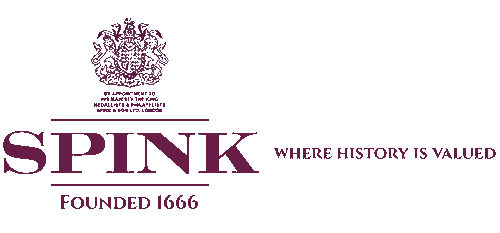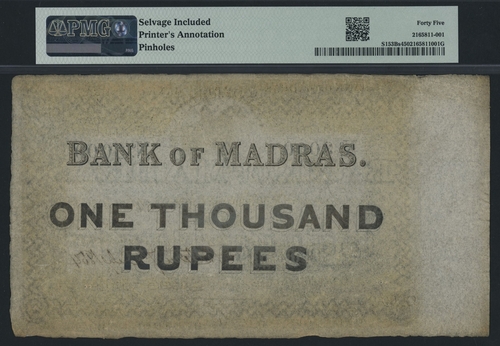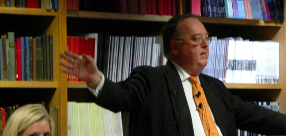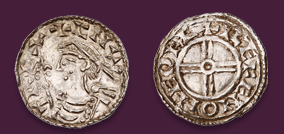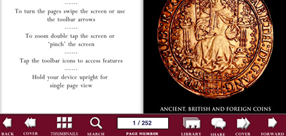Auction: 25009 - World and British Banknotes Featuring the Cassia and Cedar Collections
Lot: 46
Bank of Madras, India - British, *TOP POP* specimen 1000 Rupees, 7th July 1854, serial number 3000, Madras Presidency, Bank of Madras (1843–1861),
This extremely rare note was issued by the historic Bank of Madras, one of the three Presidency Banks that would eventually merge to form the modern Reserve Bank of India. Established on 1st July 1843, the Bank of Madras came into existence through the amalgamation of several earlier institutions — including the Madras Bank founded in 1683, the Carnatic Bank established in 1788, the British Bank of Madras created in 1795, and the Asiatic Bank formed in 1804 — and it quickly consolidated itself as the principal financial institution of the Madras Presidency during the colonial period. Its headquarters were in Madras (present-day Chennai), with branches across the major commercial centres of southern India.
The obverse is dominated by a finely engraved vignette of the equestrian statue of Sir Thomas Munro, Governor of Madras between 1820 and 1827, positioned at the centre beneath a bold semi-circular title “BANK OF MADRAS.” The denomination of “1000” is shown in all four corners, each in a different script: Arabic Siyaq, English, Tamil and Telugu, arranged in clockwise sequence. The bank’s name itself is repeated in four languages — English, Persian, Telugu and Tamil — within the upper border panels, while in the lower panels the denomination appears written in full on either side, separated at the centre by an ornate floral device. At the lower left is an additional compartment dedicated to the value. The city name MADRAS is placed between the divided date numerals directly beneath the promise of payment, with the printed serial numbers appearing on either side above that same text. Unlike circulating examples, which carried handwritten signatures of the Secretary and Treasurer together with the countersignature of the Accountant, this piece is a specimen and bears no signatures, instead showing only the inscription “Pattern” accompanied by the date. The note was produced by Perkins, Bacon & Petch of London, using their patented hardened steel plates renowned for precision and durability.
The reverse is plain in design, featuring the words “BANK OF MADRAS” together with the denomination in English. A watermark frames the paper with a triple-line angular border, enclosing at its centre the legend “BANK OF MADRAS” in straight alignment, with a version in Tamil set directly beneath. The statue depicted on the face was the work of Francis Chantrey, completed in 1839 and placed on the Island immediately south of Fort St. George, then the seat of British power in the region and now the headquarters of the Indian Army in Chennai. The Arabic numerals employed are written in the Siyaq style, a distinctive notation system derived from the older Arabic practice of writing numbers in words. Over time, these expressions were condensed into compact monogram-like forms, and in the South Asian context this evolved into the specialised commercial script known as Raqm.
(Pick S153Bs), in PMG holder 45 Choice Extremely Fine, selvage included, printer's annotation, pinholes, the sole banknote of this type graded to date by PMG
Subject to 20% VAT on Buyer’s Premium. For more information please view Terms and Conditions for Buyers.
Sold for
£80,000
Starting price
£15000
